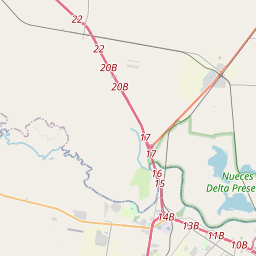Odem First Baptist Church
Historical marker location:






ON SUNDAY, APRIL 28, 1912, BAPTISTS OF ODEM ORGANIZED THEIR OWN CONGREGATION. REV. R. A. COHRAN, GENERAL MISSIONARY OF THE BLANCO ASSOCIATION, WAS CALLED TO ASSIST. WITH J. F. JANICKE AS CLERK AND W. B. JONES AS MODERATOR, REV. COHRAN READ THE ARTICLES OF FAITH AND CHURCH COVENANT, WHICH WERE ADOPTED BY THE CHURCH. WITH NO BUILDING OF THEIR OWN, THE CONGREGATION MET ONCE A MONTH AT THE METHODIST CHURCH. LATER THE ODEM TOWN SITE COMPANY DONATED LAND AT KLINE AND SELLERS STREETS, AND A FRAME SANCTUARY WAS COMPLETED. IN THE 1930s, BAPTISMS WERE PERFORMED AT SINTON AND SODVILLE.
THE CHURCH LATER MOVED TO TURNER STREET, WITH SEVERAL MEMBERS CONTRIBUTING LABOR AND MATERIALS FOR A NEW BUILDING. R. G. McDANIEL, SUPERINTENDENT OF ODEM SCHOOLS, WAS CHAIRMAN OF THE BUILDING COMMITTEE AND PAINTED THE NEW CHURCH, BUILT FOR $15,000. THE FIRST SERVICES IN THE NEW SANCTUARY WERE HELD IN MAY 1935. A TWO-BEDROOM PARSONAGE WAS COMPLETED IN 1941. THE MEMBERSHIP NUMBERED 160 AT THIS TIME AND THE SUNDAY SCHOOL WAS GROWING. HOWEVER, THE CHURCH WAS UNABLE TO SECURE BUILDING MATERIALS DURING WORLD WAR II. A 1943 CANDLELIGHT SERVICE HONORED CHURCH MEMBERS SERVING IN THE WAR. BILL SPRADLEY WAS THE CHURCH’S ONLY WORLD WAR II CASUALTY. IN THE LATE 1940s, A FARMHOUSE WAS MOVED TO THE CAMPUS FOR AN EDUCATION BUILDING. IN SEP. 1950, THE CHURCH CELEBRATED BUILDERS DAY (LATER HARVEST DAY), BENEFITING A BUILDING FUND AND STARTING A TRADITION WHICH CONTINUES TO THIS DAY. A NEW BRICK SANCTUARY WAS DEDICATED IN JULY 1951, AND NEW EDUCATION BUILDINGS WERE ADDED IN 1955 AND 1969. ODEM FIRST BAPTIST CHURCH HAS SERVED FOR A CENTURY AND WILL CONTINUE TO ENCOURAGE ITS NEIGHBORS AND COMMUNITY THROUGH MISSIONS, CHARITY AND OUTREACH
As one of the most visible programs of the Texas Historical Commission (THC), historical markers commemorate diverse topics in Texas history, including: the history and architecture of houses, commercial and public buildings, religious congregations, and military sites; events that changed the course of local and state history; and individuals who have made lasting contributions to the state, community organizations, and businesses.
The discovery of oil in 1901 near Beaumont, Texas, sparked an oil boom that transformed the state's economy and led to the rise of the modern petroleum industry.
By the early 19th century, Mexican settlers began to populate the area, leading to the establishment of San Patricio de Hibernia, a small community near the Nueces River. This settlement grew, becoming the county seat and a major center of commerce. However, as tensions grew between Mexico and the United States, San Patricio County became a focal point of conflict during the Texas Revolution. In 1836, local residents joined forces with Texan rebels to fight against Mexican forces in the Battle of Nueces.
After Texas gained independence from Mexico, San Patricio County continued to grow and develop. The discovery of oil and natural gas in the early 20th century brought prosperity to the area and attracted new industries. Agriculture, particularly cotton farming, also played a significant role in the county's economy. Over time, the county's population diversified, with immigrants from Ireland, Germany, and other parts of Europe contributing to its cultural heritage.
In recent decades, San Patricio County has continued to thrive, with the expansion of industrial and manufacturing sectors. The county is home to major refineries, chemical plants, and a naval air station. It has also become a popular tourist destination, with its coastal location offering beautiful beaches, recreational opportunities, and attractions such as the Copano Bay State Fishing Pier and the historic town of Sinton. Today, San Patricio County remains a vibrant community, embracing its rich history while looking toward a bright future.
San Patricio County Timeline
This timeline provides a condensed summary of the historical journey of San Patricio County, Texas.
- 1828 - The Mexican government grants land to Irish empresarios James Power and James Hewetson, leading to the settlement of Irish immigrants in the area that would become San Patricio County.
- 1836 - Texas gains independence from Mexico, and San Patricio County is officially established as a county of the Republic of Texas.
- 1870 - Railroads, including the Texas-Mexican Railway, begin operating in San Patricio County, boosting trade and transportation in the region.
- 1886 - The discovery of oil in neighboring Nueces County leads to the development of the petroleum industry in San Patricio County.
- 1927 - The town of Taft is incorporated, becoming an important center for the oil and gas industry in the county.
- 1941 - The Naval Air Station Corpus Christi is established southwest of Portland, becoming a major training base during World War II.
- 1961 - The construction of the Port of Corpus Christi's Ingleside Marine Terminal begins, further boosting the county's economic growth.
- 1970 - The completion of the Interstate Highway 37 connects San Patricio County to major transportation routes.
- 2017 - Hurricane Harvey makes landfall in San Patricio County, causing significant damage to the area.